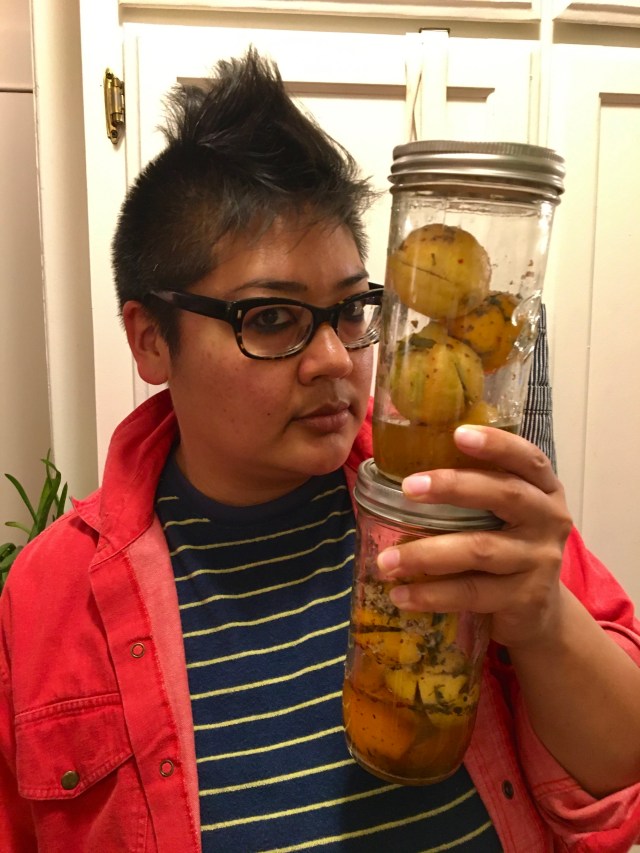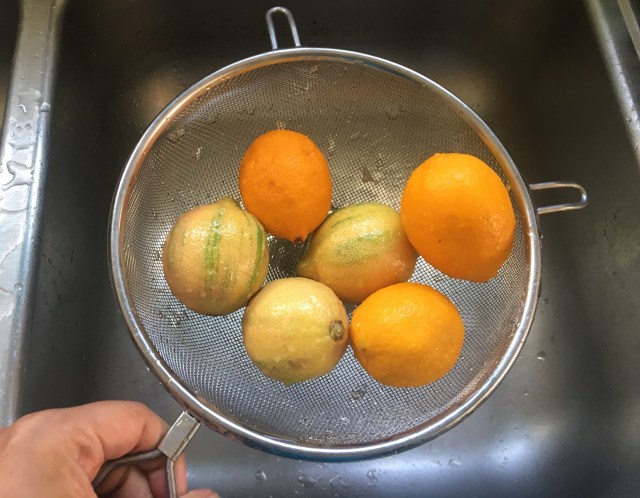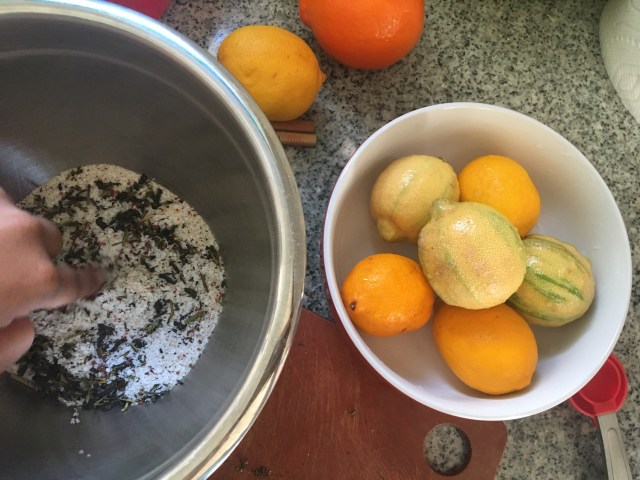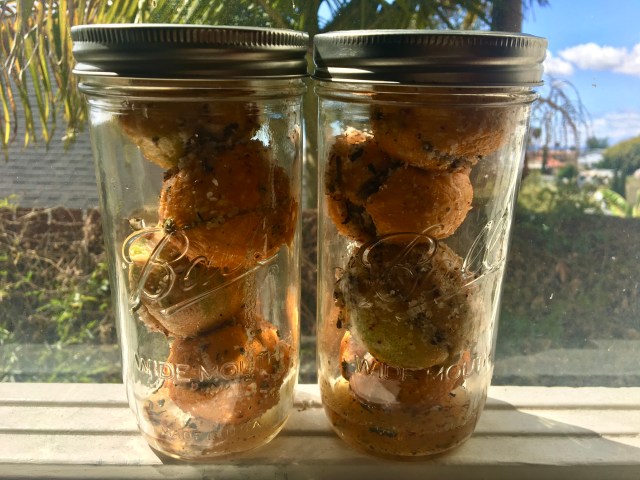
The Dyke Kitchen is a bi-weekly series about how queerness, identity, culture and love are expressed through food and cooking.
I’m the type to savor. To draw things out — past their prime, some might say. So it should be no surprise that I love preserving citrus. There’s something exciting about packing them with salt and then waiting, for at least month, before you can even begin to consider eating them. Maybe this week is just about how much I like delayed gratification. In any case, it’s winter, which is citrus season, so it’s the perfect time to preserve.

I started making preserved lemons and limes regularly back in 2013. I had eaten dried limes in Persian dishes before and had read about them in an Ottolenghi book, and so was already intrigued by salty, fermented citrus, when preserved lemon recipes started popping up in my feeds.
At the time I worked at a school district office and my co-workers were impressed when I made myself a kale salad for lunch. They were positively floored to learn that sometimes I put fresh herbs and thin slices of apple in my turkey sandwiches. Which is to say the bar for impressiveness wasn’t the highest? But that’s where I was at. I was wearing button-up shirts to work, exchanging biting quips with my my tall gay co-worker all morning and writing my novel in the afternoons at my desk. This is great news, though, because preserved lemons or limes (they have different, but equally fantastic flavor) are really tasty and incredibly easy to make.
I’m sure I found my first recipe for preserved lemons on Bon Appetit, where I love (true, not ironic) to find great, trendy recipes for the ways white people are eating these days. I don’t recall what the recipe told me to do with the lemons once they were preserved, but I’d already figured that I’d use them in all of the same ways that I use fresh lemon and my array of pickles, they’d just be kinda funky and salty. Which is exactly how it works out. I add different spices to the salt that I use to stuff the lemons every time, and that adds a slight variation in flavor, but they always turn out fragrant, just a touch bitter from the peel and the fermentation draws out that brightness of the citrus so it’s an octave lower and smooth, instead of sharp. It’s like miso in fruit form.
The first few batches I made, I boiled the lemons in water first, as was recommended by many recipes, including a previous one on this site, but I later found that this led to a very soggy preserved lemon later (not my vibe), and I don’t like extra work for no reason. There are many great ways to make these, including one on this site, but I like to think the one below is the least effort with maximum reward.
What To Do With Preserved Lemons
I’ve given a few jars to my mom before and Linda repeatedly asks me to tell her what she’s supposed to do with them. So for those who prefer to be guided in their preserved lemon journeys, these are just some of the ways that I’ve used preserved lemons and limes to great success. I will add, a little tends to go a long way because they’re preserved with salt, so I rarely use more than one quarter of a fruit at a time. Otherwise, I don’t think you can go wrong:
- Blended into a homemade salad dressing or any sauce, really: cesar, ngoc cham, BBQ
- Chopped up and cooked with the garlic and onion in a pasta
- Chopped up and mixed into an aioli
- Chopped up and mixed into a teriyaki marinade
- Chopped up and folded into my biscuit dough — also really great with cheddar and chives!
- Chopped up and added to my dhal near the end
- Chopped up in my fried rice or just with a dish I’m eating over rice
- Half of a fruit added to a pot of beans, soup or stew while they simmer
- Mashed up and mixed into butter — which you can just eat like regular butter or I might also rub it under the skin of a chicken that I’m going to roast!
- Thinly sliced on top of pizza
- Thinly sliced in my instant noodle bowl
- Minced and added to a salsa
If you already make these, please tell me how you use them!
How To Make Preserved Lemons
Ingredients (for two jars)
2 clean Mason jars (I don’t sterilize my jars, I just wash them in really hot water, but I don’t want to promote uncleanliness in our current world state, so consider sterilizing them)
8 lemons — I used Meyers for their soft skin and a nice sweetness, and pink lemons I found. My mom would also add that since you’re going to be eating the skin, you should probably go organic.
6 tablespoons Kosher salt
2 tablespoons sugar
1 teaspoon chili flakes
½ teaspoon ground coriander
2 teaspoons crushed loose tea leaves — I used a blend of mint and jasmine
A pinch of ground cloves
Keep in mind that you can use as many or as few spices as you want, and you can definitely direct your own flavor. Nobody else has to use tea, I just like how it tastes.
Directions
Wash and scrub your lemons.

Mix up all of your sugar, salt and spices (and maybe tea) in a bowl together.

With a sharp paring knife, cut three or four slits lengthwise on the fruit. You want these to start not quite at ends and go almost to that white pithy part in the middle, but in the way of cutting paper snowflakes, leave some fruit at the ends and in the middle so it holds together.
Now, my dear dykes, is where you get to gently part the slits, open them up with your fingers and start filling them with the salt mixture. Really get in there. Pack them til they’re overflowing. I’m not kidding.

Once you’ve packed all the slits on the lemon with salt, you can drop it in your mason jar and move on to the next. I usually use tall jars and can get four or five lemons or limes in each jar. Feel free to smash and squish them, it helps them get good-weird. I often dump the rest of the salt into the jar at the end, your choice.

Now, the juicy wait. Like any good crush, I put my jars in a dark place, usually in a cupboard under the sink, and let them marinate. The salt will start drawing out all the liquid in the fruits. It will collect in the jar and create a brine. Every day or two or four, I will turn the jars around so the brine bathes the lemons at the top. I usually let them sit like this and ferment for about a month. If it’s hot out, I might check in at two weeks.
People ask me how you know if something “bad” has happened to them, how to tell when they’re “off”, but I’ve never had that experience. The salt really does a good job of staving off mold.
After about a month, you’ll pop the lid, and it will just smell different in there. Like a whiff of the sea with an undertone of deep, dark lemon. Like romance. You’ll just know. If you don’t, you can check on the texture of the fruit, and once the skin has softened and the flesh is mushy, you’re in a good place!
Fill the jar with water and place in your refrigerator. You can start eating them right then, or let them go in the water for another week.
I have kept these and eaten them for a whole year and encountered no negative effects, but I’ve already told you about how I like to wait and then hold on to things too long, so maybe give yourself a couple of months to use them and move on with your life.



I’m sorry, this is the most perfect headline that has ever been published to this website.
Heather, thank you, this comment is an honor I shall frame on my wall!
Co-signed!
love love love this.
These sound really intriguing! Can I ask what the reason is for adding water at the end?
I believe the idea is to, at some point, stop the fermentation by cutting off the oxygen supply to all the good bacterias working on the lemons, but I’ll have to do some further research!
Never fermented lemons before, but I have preserved lemon skin in olive oil and pickled pith stripped skins to make a cleaning solution.
I use the oil preserved skins in garlic toasted rice and egg scramble. Can put them in the beginning and not have to take them out at any point, but I suspect they might burn if I tried to use them for something that takes longer to cook and doesn’t have any of liquid content it.
Cannot wait to try these! Thank you so much!
If anyone is coriander leaf/cilantro-averse, and is wondering about the ground coriander in the spice mix, I suggest giving ground coriander a try in something else small to see how you go. I cannot eat the fresh leaf because it tastes like stink bugs, but whatever compound is here in fresh leaf that gives it that flavour, it’s not present in the seed (or root, from what I can tell).
Also, I’ve found that even the leaf can be ok, if it is completely ground up so there are no whole flecks left – all the plant cells are burst, and the stinky compound seems to oxidise and no longer be stinky (I can eat curries if there’s no chopped leaf scattered on top).
Just a hint, because I didn’t eat coriander for many years, but I’ve found I really like the ground seed as a spice – goes super well as part of a fish rub (since we’re on the topic of lemons, ahem).
I’m so excited for these! I just tucked them away in my cabinet to do their magic. I’m making them from the lemons from a friend’s tree, so I plan on sharing these with them. I wanted to clarify something though so I can instruct my friend well on how to use and store them. You mention adding water and then leaving them like that for up to 2 weeks but then mention you’ve used them up to several months later. Do you leave them in water that whole time, or did you dump the water out at some point? Thanks for clarifying!
I’m so excited to hear about how yours turn out, and how cool that you can do these with your friend’s lemons! I add the water when the fermentation seems like it’s in a good place, in order to make it into a brine that the lemons can be stored in, in all truthfulness, for many months. It’s sort of like how you store pickled peppers or cucumbers in a liquid in a jar, just keep the liquid!
Finally got around to this. Boiled a jam jar with a narrower top than bottom, so stuffing the lemons into the jar became an adventure on its own! Looking forward to trying these out in a month.